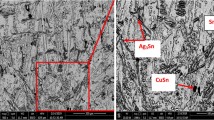Abstract
The aim of this study is to investigate the creep rupture behavior of lead-free Sn-3.5Ag and Sn-3.5Ag-0.5Cu solders at three temperatures ranging from room temperature (RT) to 90 °C, under a tensile stress range of σ/E=10−4 to 10−3. The ultimate tensile strength (UTS) and creep resistance were found to be decreased with increasing temperature for each given lead-free solder. Both the binary and ternary Ag-containing alloys exhibited superior UTS and creep strength to the conventional Sn-37Pb solder at a similar temperature. Due to a more uniform distribution of eutectic phases and a larger volume fraction of intermetallic compounds (IMCs), the Sn-3.5Ag-0.5Cu alloy had greater UTS and creep strength than did the eutectic Sn-3.5Ag solder at each testing temperature. The stress exponents (n) of minimum strain rate (˙εmin) were decreased from 7 and 9 at RT to 5 and 6 at 60 and 90 °C, for the binary and ternary lead-free alloys, respectively. Fractography analyses revealed typical rupture by the nucleation and growth of voids/microcracks at IMCs on the grain boundaries. Both Monkman-Grant and Larson-Miller relationships showed good results in estimating the rupture times under various combinations of applied stress and temperature. A model, using a term of applied stress normalized by Young’s modulus, was proposed to correlate the rupture times at various temperatures and could explain the rupture time data reasonably well for the given two lead-free solders.
Similar content being viewed by others
References
M. ABTEW and G. SELVADURAY, Mater. Sci. Eng. R 27 (2000) 95.
K. ZENG and K. N. TU, ibid. R 38 (2002) 55.
J. H. LAU, in “Solder Joint Reliability-Theory and Applications” (Van Nostrand Reinhold, New York, 1991).
M. OHRING, in “Reliability and Failure of Electronic Materials and Devices” (Academic Press, San Diego, CA, USA, 1998).
M. MCCORMACK, S. JIN, G. W. KAMMLOTT and H. S. CHEN, Appl. Phys. Lett. 63 (1993) 15.
V. I. IGOSHEV, J. I. KLEIMAN, D. SHANGGUAN, S. WONG and U. MICHON, J. Electron. Mater. 29 (2000) 1356.
V. I. IGOSHEV, J. I. KLEIMAN, D. SHANGGUAN, C. LOCK and S. WONG, ibid. 27 (1998) 1367.
W. J. PLUMBRIDGE, C. R. GAGG and S. PETERS, ibid. 30 (2001) 1178.
C. M. L. WU, D. Q. YU, C. M. T. LAW and L. WANG, J. Mater. Res. 17 (2002) 3146.
F. GUO, J. P. LUCAS and K. N. SUBRAMANIAN, J. Mater. Sci. 12 (2001) 27.
J. YU, D. K. JOO and S. W. SHIN, Acta Mater. 50 (2002) 4315.
D. K. JOO, J. YU and S. W. SHIN, J. Electron. Mater. 32 (2003) 541.
F. GUO, S. CHOI, K. N. SUBRAMANIAN, T. R. BIELER, J. P. LUCAS, A. ACHARI and M. PARUCHURI, Mater. Sci. Eng. A 351 (2003) 190.
K. WU, N. WADE, J. CUI and K. MIYAHARA, J. Electron. Mater. 32 (2003) 5.
H. G. SONG, J. W. MORRIS, JR. and F. HUA, Mater. Trans. 43 (2002) 1874.
M. L. HUANG and L. WANG, J. Mater. Res. 17 (2002) 2897.
N. WADE, K. WU, J. KUNII, S. YAMADA and K. MIYAHARA, J. Electron. Mater. 30 (2001) 1228.
H. MAVOORI, J. CHIN, S. VAYNMAN, B. MORAN, L. KEER and M. FINE, ibid. 26 (1997) 783.
M. E. LOOMANS and M. E. FINE, Metall. Mater. Trans. A. 31A (2000) 1155.
K. W. MOON, W. J. BOETTINGER, U. R. KATTNER, F. S. BIANCANIELLO and C. A. HANDWERKER, J. Electron. Mater. 29 (2000) 1122.
A. K. MUKHERJEE, J. E. BIRD and J. E. DORN, Trans. ASM 62 (1969) 155.
H. J. FROST and M. F. ASHBY, in “Deformation-Mechanism Maps” (Pergamon Press, New York, 1982).
Z. MEI and J. W. MORRIS, JR.}, J. Electron. Mater. 21 (1992) 599.
S. W. SHIN and J. YU, Jpn. Soc. Appl. Phys. 42 (2003) 1368.
Z. MEI, D. GRIVAS, M. C. SHINE and J. W. MORRIS, JR.}, J. Electron. Mater. 19 (1990) 1273.
N. WADE, T. AKUZAWA, S. YAMADA, D. SUGIYAMA, I. KIM and K. MIYAHARA, ibid. 28 (1999) 1286.
F. C. MONKMAN and N. J. GRANT, Proc. ASTM 56 (1956) 593.
F. R. LARSON and J. MILLER, Trans. ASME 74 (1952) 765.
J. CADEK, in “Creep in Metallic Materials” (Elsevier Science Publishers, Amsterdam, The Netherlands, 1988).
Author information
Authors and Affiliations
Corresponding author
Rights and permissions
About this article
Cite this article
Lin, CK., Chu, DY. Creep rupture of lead-free Sn-3.5Ag and Sn-3.5Ag-0.5Cu solders. J Mater Sci: Mater Electron 16, 355–365 (2005). https://doi.org/10.1007/s10854-005-1147-5
Received:
Accepted:
Issue Date:
DOI: https://doi.org/10.1007/s10854-005-1147-5




